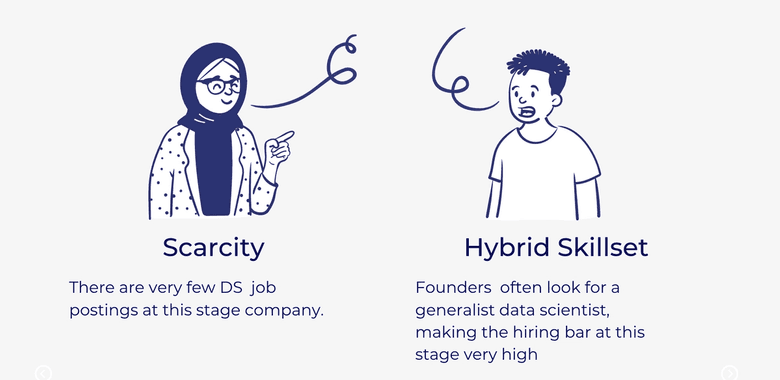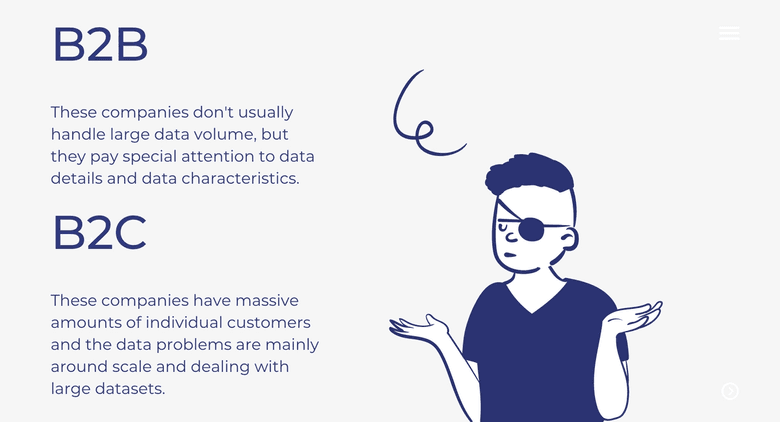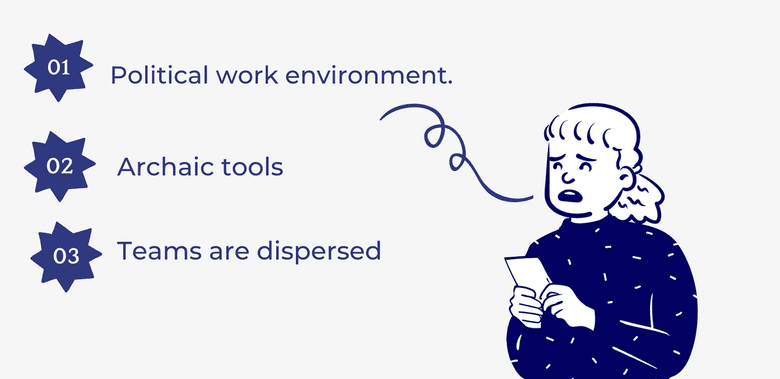Data science careers - Does company size matter?
Pick the right company for you by understanding how the role differs at different growth stages.
Not all data scientist jobs are built the same and company size matters A LOT.
Being the first data science hire in a startup is radically different than being part of a Fortune 10-- that much is obvious. But how do you compare different tech companies? Whether you're entry-level or experienced in the data science field, this can be totally opaque.
Startups & Small Companies Building Data Products

Size: Under 150 People
These companies are plentiful in the Bay Area, drawing in scientists with the promise of huge scope and creative expression on how to tackle problems.
What to expect...
You're going to be busy. Joining as an early data scientist may mean that you're doing three, sometimes 4 jobs at once - from basic things like sourcing and cleaning data, to setting up frameworks for everyone after you to use.
The hiring bar here is high. Most companies don't need a data scientist this early, but the ones that do are often run by highly credentialed founders with storied resumes (from top companies like Google or Airbnb).
A few important things to note...
- You'll be expected to work well independently or with very little direction.
- These jobs are often filled by industry veterans looking for a new challenge, or that have narrow expertise in the area the startup operates in and wide exposure across programming languages.
- Expect high workloads, work on weekends, and lower base pay than your peers at larger companies (but higher equity upside).
What the job description might look like...
Company Example: TortutaAgTech
Company Size: 17 employees use LinkedIn (11-50 company size)
Job Example: Data Scientist
Example: Data Scientist Job Description
What you’ll do
- Work with a fast-moving engineering team to leverage data collected by our robotic fruit harvesting platform.
- Work with the commercial team to understand what fruit and vegetable growers need and create valuable insights.
- Work with multivariate and ML models to build forecasting models for insights about the robots and the farms where they operate.
- Work heavily with an AWS backend to manage databases, create structure, and prepare data for analysis.
- Travel ~1-2 weeks of the year (US or international in 1-week increments) to ensure successful deployments of features and familiarity with the customer problem.
What we’re looking for
- Required: B.S. in engineering, data science, statistics, etc., plus work experience or an advanced degree in similar fields.
- Required: Exceptional ability to learn, troubleshoot, and problem-solve across software disciplines
- Required: Exceptional communication skills, in engineering and English
- Required: Comfortable with AWS, Python or R, statistical methods, and query languages including NoSQL.
- Required: Experience implementing predictive models and time series algorithms (e.g. probabilistic models, clustering, autoregression).
- Required: Experience with data science frameworks such as Pandas and scikit-learn.
- Preferred: Experience with test plan development and issue-tracking software (e.g. Jira)
Job Interpretation : The focus of this position is exceptionally strong communication with stakeholders, ability to explain results to audiences with different technical background and deep technical skills.
Startups & Small Companies Analyzing Their Own Data
Size: Under 300 People

Companies have to reach a certain size/market penetration before they need to hire a dedicated data scientist to analyze their own data and help with decision making.
What to expect...
Scarcity. These job postings are less common for smaller companies, but easier to get into than in companies who are building data tools as their main product.
The hiring bar is high here, too. Often, one of the founders had filled this role when the company was under 100 people. This can be a tough bar to interview for and founders are usually looking for a hybrid skillset:
- Data architect
- Statistician
- Data scientist with strong data visualization skills
- At least a master's degree (yes, we know that's a hefty list).
They want soft skills as well. To be successful in a data-driven company, especially as an early employee, you have to be an exceptionally strong communicator. You will also have to think creatively to solve problems. Many times, you'll be the one driving what tools the company uses.
B2B vs B2C: An important distinction.

For larger startups (100-300 people), it's important to distinguish between B2C and B2B companies. The problems you'll be working on at each would be very different.
Make sure you clearly understand the company, its business model, and data issues before you ever set foot in an interview. You should also think about what types of problems you're most passionate about and pick a company that will support your growth, in terms of skill set and industry knowledge.
B2B companies sell products to enterprises.
Examples would be Salesforce and Slack. These companies don't usually handle large data volume, but they pay special attention to data details and data characteristics. These roles focus on depth. The customers are mainly other companies, so there aren't a lot of them, but they will bring in large individual revenue.
B2C companies sell products to individuals.
Examples would be Doordash and Forward. These companies have massive amounts of individual customers and the data problems are mainly around scale and dealing with large datasets. These roles focus on width, meaning there's very little focus on individual customers (compared to B2B).
What the job description might look like...
Company Example: Masterclass
Company Size: 290 employees use LinkedIn
Job Example: Data Scientist
Example: Data Scientist Job Description
What the successful candidate brings:
- Masters degree in a related quantitative field (Computer Science, Math, Statistics, Engineering, Physics, Economics). PhDs are preferred.
- 4+ years of relevant working experience in a similar role, preferably for an online content, video, subscription or e-commerce property/platform
- Expert experience with data querying languages (e.g. SQL), scripting languages (e.g. Python), and statistical/mathematical programming languages (e.g. R, Matlab)
- Proficiency in using Redshift, PostgreSQL, RDBMS, Hadoop, Spark, or similar technologies
- Expertise with statistical analysis, applying various machine learning techniques, predictive modeling and data mining to solve business problems
- Experience with business intelligence tools (e.g. Looker, Tableau) and web analytics tools (e.g. Amplitude, Google Analytics, Adobe)
- Strategically-minded yet strong detail-orientation
- Proven ability to think creatively, solve problems, learn quickly, work independently, handle ambiguity, and adapt to change in a fast-paced environment
- Excellent written, verbal, and interpersonal communication and presentation skills
- Exemplary relationship builder who is consultative in nature and form partnerships with coworkers and customers
Job Interpretation: The focus of this position is on finding someone who can " plug into" an existing process at the company and work as a team player.
Fortune 500 & Mid-Sized Companies Analyzing Their Own Data

Size: Over 10,000 People
Especially in finance, it's not uncommon that these positions are coveted. Many companies, such as First Republic Bank, have carve-outs in their budget for their data science teams. Established companies invest significantly in technology and talent to make sense of their own data.
What to expect...
Shifted requirements. The data science interview at these companies is usually much easier but the requirements around having an advanced degree, like a master's degree or even PhD, can be much stricter.
Composed of independent teams. Sometimes, these teams operate like their own startups inside a larger company - almost completely separate from the rest of the org and relied upon for key business intelligence. It's increasingly frequent that companies hire out of the market to manage talent costs.
A different job focus. These companies are more likely to be using Tableau and Excel than Hadoop, and many data scientist jobs are more akin to being a business analyst at a tech company. There's a very heavy emphasis on data visualization, rather than data analytics.
These jobs are really what you make of them. You can coast and do some rudimentary business analytics, but if you're very ambitious, it's also an amazing opportunity to build something unique. Having millions of customer data points can bring unlimited possibilities for data science. Taking Wal-Mart's procurement data as an example: the analysis results will affect the lives of millions of people. Companies of this size are seldom known for cutting-edge data science solutions, but processing their data sets is still a challenge.
Office politics are necessary to get ahead. Many of these companies have low professional development knowledge for IC data scientist roles. Therefore, expect to have to learn politics and deal with some bureaucracy if you want to get ahead. Risk aversion is usually very high and you might be restricted in what tools you can use (due to information security concerns).
What the job description might look like...
Company Example: JP Morgan
Company Size: More than 55,000 employees use LinkedIn
Job Example: Data Scientist
Example: Data Scientist Job Description
The Data Scientist is an individual contributor that should be able to apply quantitative, data science and analytical skills to complex problems. He/or she should be able to work across teams to design, develop, and evaluate and execute against those data science and analytical solutions with a keen functional understanding of the business problem. He/she will be responsible for data wrangling, data analysis, modeling, including model selection and producing quick applicable modeling solutions.The Associate will serve as a thought leader including advising on optimal solutions and opining on challenger models. The role works on strategic, highly visible projects firm wide. It is an opportunity to have meaningful impact on a large scale at a leading financial services firm. The role will develop data-centric solutions that move the bottom line for the firm.
In Corporate Technology Machine Learning at JPMorgan Chase, our charter is to solve challenging business problems through machine learning across not only all the corporate functions, but also the four core operating segments of the bank. The challenges involve but are not limited to automating business processes, better decision making and improving operational efficiency. A diverse set of machine learning techniques can be employed for example, decision trees/random forests/GBM; Natural Language Processing and Generation (NLP/NLG); Text Mining.
Job Interpretation: Compared to other jobs, there are much lower requirements for communication. This is a heads-down operational role with no decision making authority.
FAANG & Large Companies With Mature Data Teams

World-class, large companies like Uber, Airbnb, Facebook, and Google have dedicated technical teams led by industry elites.
What to expect...
A top-tier experience. Working at these companies, you will deal with large scale data sets, touch on the most cutting-edge data problems, and use the best tools. The talent pool here will really test your data science skills.
Prestige and money. These roles are considered prestigious and command a high average salary. While they are hard to land, these roles are the career opportunities of a lifetime and can give you the right credentials to be a founder down the line.
What the job description might look like...
Company Example: Facebook
Company Size: More than 58,000 employees use LinkedIn
Job Example: Data Scientist (Product)
Example: Data Scientist (Product) Job Description
DATA SCIENTIST, PRODUCT ANALYTICS RESPONSIBILITIES
- Apply your expertise in quantitative analysis, data mining, and the presentation of data to see beyond the numbers and understand how our users interact with both our consumer and business products
- Partner with Product and Engineering teams to solve problems and identify trends and opportunities
- Inform, influence, support, and execute our product decisions and product launches
- The Data Scientist Analytics role has work across the following four areas:
- Product Operations
- Forecasting and setting product team goals
- Designing and evaluating experiments
- Monitoring key product metrics, understanding root causes of changes in metrics
- Building and analyzing dashboards and reports
- Building key data sets to empower operational and exploratory analysis
- Evaluating and defining metrics
- Exploratory Analysis
- Proposing what to build in the next roadmap
- Understanding ecosystems, user behaviors, and long-term trends
- Identifying new levers to help move key metrics
- Building models of user behaviors for analysis or to power production systems
- Product Leadership
- Influencing product teams through presentation of data-based recommendations
- Communicating state of business, experiment results, etc. to product teams
- Spreading best practices to analytics and product teams
- Data Infrastructure
- Working in Hadoop and Hive primarily, sometimes MySQL, Oracle, and Vertica
- Automating analyses and authoring pipelines via SQL and Python based ETL framework
The information provided herein is for general informational purposes only and is not intended to provide tax, legal, or investment advice and should not be construed as an offer to sell, a solicitation of an offer to buy, or a recommendation of any security by Candor, its employees and affiliates, or any third-party. Any expressions of opinion or assumptions are for illustrative purposes only and are subject to change without notice. Past performance is not a guarantee of future results and the opinions presented herein should not be viewed as an indicator of future performance. Investing in securities involves risk. Loss of principal is possible.
Third-party data has been obtained from sources we believe to be reliable; however, its accuracy, completeness, or reliability cannot be guaranteed. Candor does not receive compensation to promote or discuss any particular Company; however, Candor, its employees and affiliates, and/or its clients may hold positions in securities of the Companies discussed.
